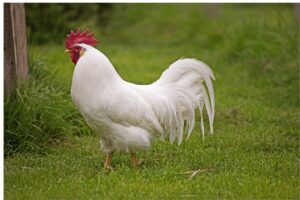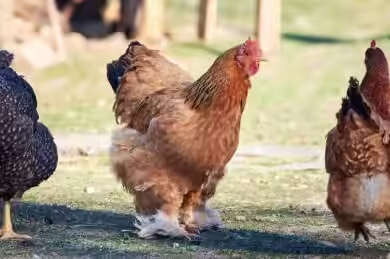Last updated on August 7, 2025
Why Are Leghorns Not Ideal for Beginners? Considering chickens? Leghorns are known for many white eggs.
Truth: Leghorns are egg-laying powerhouses, but not ideal for beginners. Their flighty, high-energy nature and handling difficulty challenge new keepers. This guide explains why, offers practical tips for success, or helps you find a better fit.
Leghorns aren’t bad chickens—they’re just built for a different kind of keeper: experienced, patient, and prepared.
My first flock included a Leghorn. I spent more time chasing her off the fence than collecting eggs. It was a steep learning curve!
Why Are Leghorns Not Ideal for Beginners? (Quick Answer)
Leghorns aren’t ideal for beginners due to their flighty behavior, difficulty with confinement, and high energy. They require specific handling and secure setups.
They’re fantastic for the right environment, but that often means more experience.
The Traits That Make Leghorns Challenging for New Chicken Keepers
Leghorns’ breeding for egg production, not docility, makes them active, nervous, and hard to handle for new keepers.
Leghorns are the Olympic athletes of the chicken world. Bred for one purpose: laying eggs, with incredible efficiency.
This focus developed traits not “lap chicken” material.
They’re incredibly active, always moving, with a strong instinct to forage and explore.
High energy and a nervous disposition mean easy startling. They often choose flight.
For new keepers, this frustrates hopes for friendly companions.
Can First-Time Chicken Keepers Raise Leghorns Successfully?
Yes, but success requires extra effort, ample space, and patience to manage their unique needs.
It’s not impossible, but it’s a steeper learning curve than with, say, a Buff Orpington.
If highly motivated and able to offer space, structure, and patience, you can make it work. Just don’t expect them to greet you at the coop door.
Why Are Leghorns Harder to Raise Than Other Breeds?
To grasp why Leghorns can be a handful, understand their DNA. They aren’t typical docile backyard pets.
Breed Origin and Purpose (Why They Were Bred To Be Performance Machines)
Leghorns were bred in Italy and refined in the U.S. specifically for high commercial egg production, prioritizing output over temperament.
Breeders focused relentlessly on maximizing egg output, feed conversion, and hardiness. Temperament wasn’t a priority.
They were designed as efficient layers, not friendly farm companions.
Flightiness and Nervous Disposition
Leghorns are naturally skittish and easily startled, often choosing to flee from perceived threats, making daily interactions challenging.
This is their defining characteristic. Leghorns are notoriously flighty and skittish.
They’re easily startled by sudden movements, loud noises, or unfamiliar people.
This nervous energy means they’re quick to run, flap, or even fly from perceived threats (including you).
This can make daily tasks like collecting eggs feel like a high-stakes chase. As one experienced keeper noted on a forum, “Different strains behave differently but usually Leghorns are timid and flighty and so not for the inexperienced.”
High Activity Levels and Need for Space
Leghorns are agile, high-energy birds that thrive with significant space to roam and forage, making small confinements stressful.
They love to roam, scratch, and forage with boundless energy.
This high activity level means they need significant space to stay happy and healthy.
Confining them to a small coop or run can lead to boredom, stress, and behavioral issues. They thrive with room to explore.
Which Breeds Are Better Than Leghorns for Beginners?
To truly appreciate why Leghorns aren’t for everyone, let’s look at easier breeds for beginners.
Leghorns vs. Orpingtons, Australorps, and Barred Rocks
Here’s a quick comparison of Leghorns against some recommended beginner breeds:
| Trait | Leghorn | Buff Orpington | Australorp | Barred Rock | Rhode Island Red |
|---|---|---|---|---|---|
| Personality | Flighty, nervous, independent | Docile, friendly, calm, cuddly | Calm, friendly, curious, hardy | Docile, adaptable, good foragers | Active, generally friendly |
| Egg Output | 280-320+ white eggs/year | 180-200 light brown eggs/year | 250-300+ brown eggs/year | 250-300+ brown eggs/year | 200-280 brown eggs/year |
| Handling Difficulty | High (skittish, hard to catch) | Low (calm, enjoys interaction) | Low (easy to handle) | Low (calm, adaptable) | Moderate (can be assertive) |
| Flightiness/Escape Risk | Very High (excellent flyers) | Very Low (heavy, rarely flies) | Low (not prone to flying) | Low (not prone to flying) | Moderate (can fly, but less) |
| Coop/Run Recommendations | Large space (15-20 sq ft/bird), 6ft+ fences, enclosed run | Tolerates confinement well, standard coop/run | Tolerates confinement well, standard coop/run | Tolerates confinement well, standard coop/run | Good space, enjoys foraging |
| Climate Adaptability | Heat-tolerant, cold-sensitive combs | Cold-hardy, heat-tolerant | Very hardy, adaptable to most climates | Very hardy, good in cold | Very hardy, good in cold |
| Ideal Beginner Rating (1-5) | 1 | 5 | 4 | 4 | 3 |
What’s the Best Chicken Breed for Beginners (Compared to Leghorns)?
For most beginners, calmer, friendlier, and more confinement-tolerant breeds like Buff Orpingtons, Australorps, and Plymouth Rocks are ideal choices.
For most first-time chicken keepers, breeds like Buff Orpingtons, Australorps, Plymouth Rocks (especially Barred Rocks), Wyandottes, and Rhode Island Reds are far better choices. They are generally:
- Calmer and more docile: Easier to handle, less prone to panic.
- More tolerant of confinement: Better for smaller backyard setups.
- Friendlier: More likely to become pets, interact positively.
- Hardier: More adaptable to climates, less prone to stress.
Choosing Based on Your Climate, Goals, and Setup
Select a chicken breed based on your available space, local climate, specific goals (eggs, meat, pets), and the time you can commit to care and training.
When picking your first flock, consider:
- Your space: Small backyard or acres to roam?
- Your climate: Heat-hardy or cold-hardy birds?
- Your goals: Eggs, meat, or friendly pets?
- Your time commitment: How much time for handling and training?
For a gentle start, prioritize temperament and ease of care over sheer egg numbers.
Common Challenges New Keepers Face with Leghorns
Beyond temperament, Leghorns present practical struggles for new owners.
Difficulty Handling and Socializing
Quick Answer: Leghorns are not naturally affectionate; handling them for routine care or taming them requires consistent effort and patience.
If you dream of chickens sitting on your lap, a Leghorn might not be your best bet, initially.
They aren’t naturally affectionate or curious about humans.
Catching them for health checks can be frustrating; they’ll often dart away.
Socializing them requires consistent, gentle handling from a young age; some remain aloof.
Tendency to Flee, Roam, or Escape
Leghorns are excellent flyers and have a strong instinct to escape, making standard fencing insufficient for containment.
Their flightiness isn’t just about being hard to catch; it’s their strong instinct to escape.
Leghorns are excellent flyers, clearing standard 4-foot fences with ease. I learned this firsthand when my Leghorn chick, barely a few weeks old, flapped right over the brooder wall the first time I turned my back. They’re escape artists from day one!
If you have neighbors, a busy road, or predators, this quickly becomes a major headache.
Notoriously Hard to Contain with Standard Coops
Standard backyard coops and runs often fail to contain Leghorns due to their flying ability and desire to roam.
Due to their aerial abilities and desire to roam, standard backyard coop setups often aren’t enough.
You’ll likely need higher fencing (at least 6 feet, ideally) or a fully enclosed run for safe containment.
If you can’t provide ample space, they will find a way out, or become stressed and unhappy.
Can Leghorns Stay in a Small Backyard?
Quick Answer: No, Leghorns are generally not suitable for small backyards; their high energy and flightiness demand extensive space and very secure containment.
They require much more room than typical backyard breeds to avoid stress and escape attempts.
More Susceptible to Stress-Related Issues
Leghorns’ high-strung nature makes them prone to stress, leading to problems like feather-picking, reduced laying, and increased risk of illnesses such as peritonitis.
Confinement, overcrowding, lack of enrichment, or too much human interaction can lead to these problems.
Expert Tip: “If you can’t give them at least 10–15 square feet per bird in their run, expect trouble.”
Are Leghorns Aggressive? How They Behave Around Humans & Other Chickens
Common questions: “Are Leghorns friendly?” or “Will they bully other chickens?” The answer is nuanced.
Pecking Order Behavior and Dominance
While not aggressive in the way some roosters can be, Leghorns can dominate quieter breeds and appear “mean” simply due to their energy and speed.
They can be bossy, especially towards more docile breeds.
In a mixed flock, they might peck at slower chickens, monopolize feeders, or assert dominance.
This isn’t aggression, but a manifestation of their energetic personality.
Can Leghorns Be Tamed or Made Friendly?
Leghorns can be tamed with consistent, gentle handling from a young age, but they will likely remain independent rather than becoming cuddly pets.
It takes time, patience, and consistent effort from chick age.
Regular, gentle interaction, treats, and a calm environment help them relax.
It took me weeks to get my Leghorn to eat from my hand; once she did, she relaxed a lot.
Don’t expect cuddly lap chickens like a Buff Orpington. Their natural instinct is independent and alert.
Can You Make It Work? Tips for Raising Leghorns as a Beginner
If determined to raise Leghorns as a beginner (I admire your grit!), here are crucial tips for success.
Coop Design and Space Requirements
Leghorns require ample space, including at least 15-20 sq ft per bird in the run and high, secure fencing (6ft minimum) or an enclosed top to prevent escapes.
Leghorns need ample space.
- Run Size: Aim for at least 15-20 sq ft per bird in the run, especially if not free-ranging extensively. More is always better.
- Fencing: A 6-foot fence is minimum; a fully enclosed run (with netting) prevents escapes and protects from predators.
- Perches: Provide plenty of high perches; they love to roost high.
- Nesting Boxes: Ensure secure, private nesting areas. Leghorns sometimes “hide” eggs if feeling exposed or too free.
How Much Space Does a Flighty Leghorn Actually Need?
A flighty Leghorn needs a minimum of 15-20 square feet per bird in their run, plus a secure coop, to prevent stress and escape attempts.
This generous space allows them to express their natural foraging and active behaviors without feeling confined.
Reducing Flightiness with Handling and Enrichment
Consistent, gentle handling from chick age, along with providing toys and foraging opportunities, can help reduce Leghorns’ nervous energy and flightiness.
Consistency is key to calming nervous chickens.
- Handle Early and Often: Start handling chicks from day one. Gently pick them up, talk to them, and offer treats. Early positive human interaction means more comfort as adults.
- Treats as Bribery: Use treats (like mealworms or scratch grains) to encourage them to approach you.
- Enrichment: Boredom leads to stress. Provide toys, swings, dust bath areas, and foraging opportunities. A hanging cabbage or pecking block keeps them busy, reducing nervous energy.
Feeding and Care Tips for High-Energy Layers
High-energy Leghorns need a protein-rich layer feed (16-18%), free-choice calcium, constant fresh water, and careful monitoring for stress-related health issues.
Leghorns are egg-laying machines; that takes fuel.
- High-Quality Layer Feed: Provide a high-protein (16-18%) layer feed to support intense egg production.
- Calcium Supplement: Offer free-choice oyster shell for strong eggshells.
- Fresh Water: Always ensure a constant supply of clean, fresh water.
- Monitor for Stress: Watch for signs of stress like feather-picking, reduced appetite, or decreased egg production. Address potential stressors immediately.
Short direct answer box: “Yes, but only if you can offer space, structure, and lots of patience.”
What Leghorns Are Excellent At (And Why They Still Have a Place)
Despite challenges, Leghorns aren’t just commercial; they have outstanding qualities for the right keeper.
Egg-Laying Powerhouse: Up to 280+ White Eggs/Year
Leghorns are renowned for prolific white egg production, consistently laying 280-320+ eggs annually, making them highly efficient layers.
This is their claim to fame. Leghorns are incredibly prolific layers, consistently producing large white eggs. Many strains lay 280 to over 320 eggs per year, making them highly efficient [^1].
If your primary goal is a steady supply of white eggs, they are hard to beat.
Heat Tolerance and Efficient Feed Conversion
Leghorns excel in warm climates due to their efficient heat dissipation and convert feed into eggs very effectively, requiring less feed per egg than heavier breeds.
Leghorns are well-suited for warmer climates. Their smaller body, single comb, and active nature help dissipate heat efficiently.
This makes them excellent choices for Southern U.S. flocks where other breeds might struggle.
However, their large combs and wattles make them susceptible to frostbite in very cold climates, so proper winter housing is crucial.
They also convert feed into eggs very efficiently, meaning less feed per egg produced than heavier breeds.
Ideal for Free-Range, Large Properties
Leghorns thrive on large properties with free-range access, as their natural roaming and foraging instincts are best met in open spaces.
If you have a large property where chickens can truly free-range and forage over acres, Leghorns can be an excellent fit.
Their natural inclination to roam and foraging prowess mean they’ll happily spend days exploring, eating bugs, and largely caring for themselves.
They thrive where they have ample space to express natural behaviors.
Stat Visual: Egg count comparison: Leghorn vs. Buff Orpington vs. Plymouth Rock.
- Leghorn: 280-320+ eggs/year
- Buff Orpington: 180-200 eggs/year
- Plymouth Rock: 200-280 eggs/year
Final Verdict: Should Beginners Raise Leghorns?
So, what’s the final word?
Some sources, like “Brown’s Farmstead,” might suggest Leghorns are beginner-suitable. However, based on their inherent traits, a nuanced view is essential. While hardy in some ways, their specific needs often pose challenges for first-timers.
When It Might Make Sense (and When It Definitely Doesn’t)
Leghorns suit beginners with ample space, secure setups, and patience for their independent nature; they are not for small backyards or those seeking cuddly pets.
It definitely doesn’t make sense if:
- You have a small backyard with limited space.
- You have young children wanting close interaction.
- You’re looking for cuddly, docile pets.
- You’re not prepared to invest in high, secure fencing or a fully enclosed run.
- You have limited time for consistent handling and enrichment.
It might make sense if:
- You have ample acreage for them to free-range.
- Your primary goal is maximum white egg production, and temperament is secondary.
- You are highly motivated, patient, and willing to put in extra effort for handling and coop security.
- You have prior experience with other livestock or animals needing a hands-off approach.
Better Alternatives for a Gentle Start into Chicken Keeping
For an easier start, opt for calm, friendly, and confinement-tolerant breeds like Buff Orpingtons, Australorps, or Plymouth Rocks.
For a truly gentle and rewarding introduction to chicken keeping, I strongly recommend starting with breeds known for calm temperament and hardiness. Consider:
- Buff Orpingtons: The epitome of a friendly, docile backyard chicken.
- Australorps: Excellent layers with a calm, friendly disposition.
- Plymouth Rocks (especially Barred Rocks): Hardy, adaptable, and generally good-natured.
- Wyandottes: Beautiful, cold-hardy, and calm.
- Rhode Island Reds: Great layers, active but generally friendly.
Decision Box: “Choose Leghorns only if you have secure fencing, patience, and aren’t expecting lap chickens.”
Starting with a more beginner-friendly breed allows you to learn basics without the stress of managing a flighty flock.
Once you’ve got experience, then, by all means, consider adding a Leghorn if you’re up for the challenge!
FAQs About Leghorn Chickens –
Are Leghorn chickens good for beginners?
No, Leghorns are generally not ideal for beginners due to their flighty nature, high energy, and handling difficulty. They suit more experienced keepers.
What are the disadvantages of Leghorn chickens?
Disadvantages include their flighty and skittish temperament, difficulty with handling, tendency to escape, high need for space, and susceptibility to stress-related issues if confined.
How aggressive are Leghorns?
Leghorns aren’t typically “mean” but can be bossy due to their high energy, often dominating the pecking order in mixed flocks.
Can Leghorn chickens be friendly?
They can be tamed to a degree with consistent, gentle handling from a young age and treats. However, they are naturally independent and alert, not typically cuddly.
What’s the best chicken for beginners?
For beginners, calmer, friendlier, and more confinement-tolerant breeds like Buff Orpingtons, Australorps, Plymouth Rocks, Wyandottes, and Rhode Island Reds are better choices.
What are Leghorn chickens known for?
Leghorns are primarily known as prolific white egg layers, producing 280-320+ eggs per year. They are also known for heat tolerance and efficient feed conversion.
What are chickens most scared of?
Chickens are generally scared of sudden movements, loud noises, and predators (including aerial threats). Their flighty nature makes them easily startled.
Are Leghorns disease resistant?
The document highlights that Leghorns are “more susceptible to stress-related issues” which can increase their health risks if not managed well, implying they may not be as disease-resistant under poor conditions.
Ready to start your flock?
Dive deeper into essential chicken care and discover more beginner-friendly breeds to ensure a happy, healthy start to your chicken-keeping journey!
- 15 Simple Secrets to Raising Happy, Healthy Chickens That Actually Lay Eggs
- Golden Comet Chickens: A Beginner’s Favorite
Should You Get Leghorns? A Quick Quiz
1. Do you have ample space for chickens (at least 10+ sq. meters per bird in the run) and secure fencing (6ft+ or enclosed)?
Further Resources
- Leghorn Chicken Characteristics – Learn more about the Leghorn breed’s traits from Oklahoma State University Extension: https://breeds.okstate.edu/poultry/chickens/leghorn-chickens.html
- Chicken Breed Selection – Explore a comprehensive guide to choosing the right chicken breed for your needs from Ohio State University Extension: https://ohioline.osu.osu.edu/factsheet/anr-60
[^1]: University of Illinois Extension. “U of I Poultry Program Facts.” https://extension.illinois.edu/sites/default/files/embryology_poultry_fun_facts.pdf


